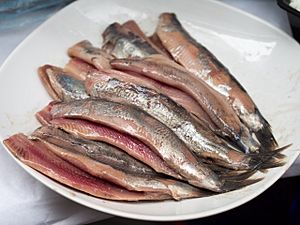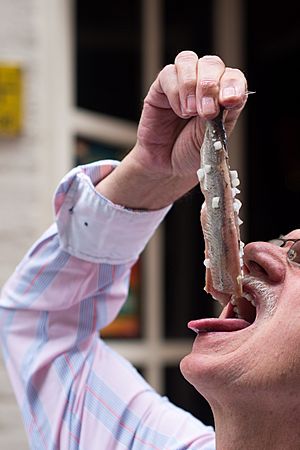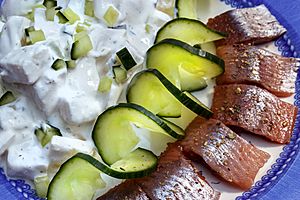Soused herring facts for kids

Lightly brined raw herring, also known as Hollandse Nieuwe, Netherlands
|
|
| Place of origin | Netherlands |
|---|---|
| Main ingredients | Herring, vinegar; any of cider, wine, tea, sugar, herbs (usually bay leaf), spices (usually mace), chopped onion |
Soused herring is a special type of herring fish that has been soaked in a mild liquid to keep it fresh and give it flavor. This liquid can be a light vinegar pickle or a salty water mix called brine. Besides vinegar, the liquid might also have cider, wine, tea, sugar, herbs (like bay leaf), spices (like mace), and chopped onion.
Sometimes, the word 'soused' can also mean a herring that was cooked first, then soaked in the flavored liquid. This cooked version is usually baked or fried and then served cold. You'll often find this type in Scotland, Wales, and Ireland.
In Dutch, this dish is called maatjesharing or maatjes. In German and Swedish, it's called Matjes. This kind of soused herring is very mild because it's made from young, small herrings. These fish are kept in salty water in wooden barrels for a few days. Natural helpers (enzymes) inside the fish make it extra soft and mild. Another type of pickled herring, called rollmops, is made by pickling raw herring in vinegar.
Some types of soused herring, like 'Hollandse Nieuwe' from the Netherlands and 'Glückstädter Matjes' from Germany, have special certifications. These certifications mean they are made in a traditional way in specific places. Soused herring can also be part of a traditional twelve-dish Christmas Eve supper in Poland.
History of Soused Herring
The special way of preparing herring, known as "gibbing," was first developed hundreds of years ago by people in the Netherlands. Herrings are usually caught between late May and early July in the North Sea, near Denmark or Norway. This is before they start to lay eggs, which is when the fish are extra rich in healthy oils (more than 15%).
The salty water (brine) used for Dutch soused herring is much milder than some other types. To make sure the fish is safe to eat and free from tiny worms called nematodes, rules in places like the European Union say that the fish must be frozen at a very cold temperature (minus 20 degrees Celsius) for at least 24 hours. Because of this freezing step, soused herrings can now be made and enjoyed all year round.
How Soused Herring is Made
To prepare the herring, a small cut is made in its throat. The gills and part of the throat are carefully removed. This helps to get rid of any bitter taste. However, the liver and pancreas are left inside the fish. These organs release special helpers (enzymes) that are very important for giving the herring its unique flavor during the soaking process.
After this, the herrings are placed in the salty water (brine) for about five days. Traditionally, this was done in oak barrels. Once they are ready, the fish don't need much more work. Their skin and bones are removed, and then they can be eaten. They make a tasty snack, often served with thinly sliced raw onion and pickles.
Removing the skin from soused herring can be a bit tricky and takes practice. It's often easier to start with fillets (pieces of fish without bones). When you buy soused herring, it should look shiny and silver on the outside and pink on the inside if it's fresh. If it looks grey and oily, it's best not to buy it.
Some salty herrings have a lot of salt (about 20%) and need to be soaked in water before you can eat them. But soused herrings have less salt and don't need to be soaked at all.
Serving Soused Herring
In the Netherlands, soused herring is often eaten as a quick snack. It's usually served plain, or with some chopped onions. Many people eat a whole herring by holding it by its tail and lifting it up to their mouth.
In Northern Germany, soused herring dishes are traditionally served with potatoes boiled in their skins, green beans, crispy fried bacon, and onions. It's also common in Germany to eat soused herring in a bread roll with sliced raw onions. This is called Matjesbrötchen.
In some areas, like Holstein, soused herring is served on dark bread with a sauce made from cowberries and cream. You can also find soused herring served with creamy sauces, like those made with cream or yogurt, often with onions and small pickles (gherkins). It's also a popular ingredient in salads.
In Sweden, matjessill is a traditional dish served with boiled potatoes, sour cream, chopped chives, crisp bread, and a small glass of snaps (a strong alcoholic drink). Boiled eggs are also popular with this meal. It's a very traditional dish for Midsummer's Eve. Finland has a similar custom, but their silli is not usually eaten with crisp bread. Today, many Swedes and Finns eat herring that comes in cans, already sliced and with added sugar. The Swedish matjessill is often more strongly spiced than other kinds.
See also
 In Spanish: Matjes para niños
In Spanish: Matjes para niños




